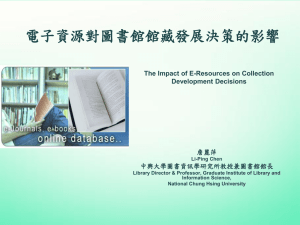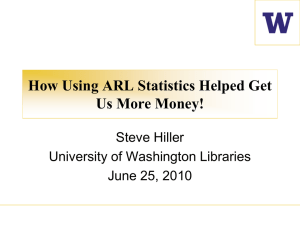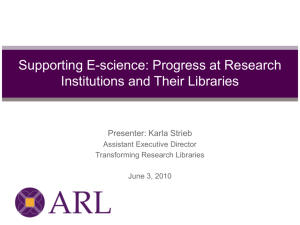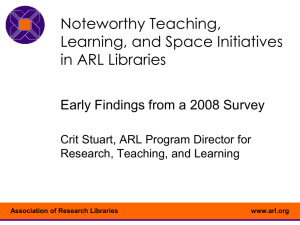Madaus presentation SDLN 20060920
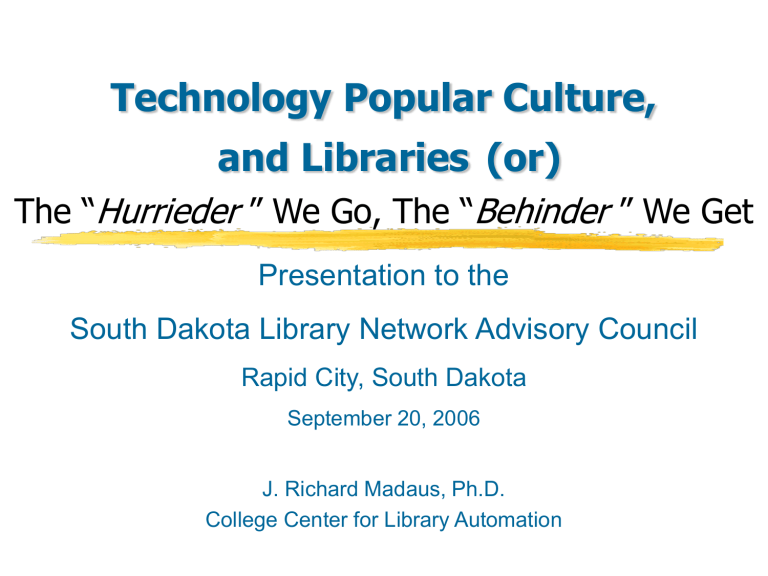
Technology Popular Culture, and Libraries (or)
The “ Hurrieder ” We Go, The “ Behinder ” We Get
Presentation to the
South Dakota Library Network Advisory Council
Rapid City, South Dakota
September 20, 2006
J. Richard Madaus, Ph.D.
College Center for Library Automation
Before we start – let’s mention the world of books
They are still here
There will never be enough budget to buy all the ones we need
Book sales data from the Book
Industry Study Group (BISG)
1993 – 19 Billion Dollars
2002 - 34.8 Billion Dollars
2003 - 36.5 Billion Dollars
2004 - 38.4 Billion Dollars
2005 – 40+ Billion Dollars?
Multiple foundations of information resources supporting library services
Proprietary
Electronic
Free Web
“We are not who we are by the talents and abilities we possess.
We are who we are by the choices we make.”
-- Albus Dumbledore
Evaluation of Internet Sources
JPEG 2000
Metadata Harvesting
Preservation of New Media Formats Infrared
PDAs/Portability of Data
Personal Search Software
OPACs and User Behavior Blogging
Copyright
Self-Publishing
Storage/Organization of Data
Spam Filters
Home Scholar RFID
RSS
Web Usability Data Transmission
XML
Interoperability
Hiring good Systems personnel
E-Resource Management
Trust Management
Handhelds
Open Source
Open URL
Death of MARC
What’s important
Automating Reference
RIGHT NOW?
Open Access
Web Services
Scanning vs. Reading
Wireless/ Wireless Security
Personal Information Management(PIM)
Privacy and Electronic Confidentiality
Biometrics
Broadband
Human Factors
Submerging Technologies
Integrated Online Library Systems
Authentication and Rights Management
Institutional Repositories
Policies and Technology
User Interface Design
User Centered Design
Search Engines and Research
Security, Digital Rights Management
Metasearching/Federated Searching
USA Patriot Act Game Technology Customization and Personalization
How much do WE allow the new technologies to change our services?
How much do we really know about the information seeking/using habits of the popular culture in the world around us?
How much of popular cultural behavior has real implications for library services?
And what actions do we take based on what we think we now know?
Let the adventure begin.............
OCLC
Marketplace Trends 2003
tell us that…
Information may now be viewed as being “good enough” by the user whether it is “THE” answer or not –
the user may no longer care about the level of authenticity, if the answer provided is “good enough” from their perspective.
Marketplace Trends 2006
The 2003 OCLC Environmental Scan is now a historical document
Oh, by the way, that means it’s old and in the past !
So what should we expect in the 2008
Environmental Scan?
But wait ― there’s more!!!...
Perceptions of Libraries and Information Resources (2005)
The findings indicate that information consumers view libraries as places to borrow print books, but they are unaware of the rich electronic content they can access through libraries. Even though information consumers make limited use of these resources, they continue to trust libraries as reliable sources of information.
Cultural trends versus library realities…
Let’s take a few moments to explore the speed of trends in consumer focused technologies and cultural behavior
How many of us are planning services for these users?
Slide from a 2001 presentation:
Slide from 2004 presentation
And in September 2005 ...
Then one month later...
The marketplace expands and converges at the same time...
VCAST
Understanding the speed of technology trends
As the “gizmos” keep changing, entirely new markets and ways of doing things become commonplace almost overnight !
An Interesting Experiment...
Stop and think about this...
The 57,000,000 MARC records of OCLC
WorldCat will fit in 24 Gigabytes of a 40
Gig Ipod with a lot of room left over
(It’s actually been done according to Gary
Houk of OCLC)
So what’s next?
Another slide from a 2001 presentation:
Moving beyond the simple I-Pod world...
Mobile devices are converging on and within the overall information marketplace
It isn’t just Apple computer that is in this business and there are already billions being made...
A slide from a 2003 presentation
Same Web site − 2006
Same Web site − 2006
Another I-Pod competitor...
Award winning I-Pod competitor...
The real move to portable media...
THIS WEEK 2006 web site
TIVO jumps in...
DISH-TV won’t be left out...
More and more mobility...
Not to mention...
Mobile computing from Sony...
Windows based portable media...
Stop and think about this
If WorldCat will fit in your pocket and everything is connected to everything else ― what are the implications for libraries ?
Is this a reality for the far future?
Or only a few moments from yesterday!
Now, a moment to ponder…
We are not that far from a TERABYTE (1000
Gig) in the pocket! (probably within five years)
How soon can we start planning library service for PetaByte (1000 TeraBytes) resources in the pocket? (probably within ten years)
However, we probably don’t need to think about ExaBytes for a couple of years yet.
Or, maybe ExaBytes will be here pretty quickly
But wait ― Let’s talk a little more about research…
Have you looked closely at your versions of Windows Office products?
Have you found the <RESEARCH> button in Word 2003?
Let’s take a quick peek…
And if we are going to talk about research…
We must mention the impact of
An interesting comparison...
OCLC exists to further access to the world’s information and reduce library costs by offering services for libraries and their users.
Google's
mission is to organize the world's information and make it universally accessible and useful.
So… what’s next?????
The Successor(s) to Google?
Faceted Searching Approaches?
Clustered Searching Approaches?
???
Big trends on the way...
User based meta-tagging
Personalization moves to “steroid” levels
Social software
???
Important trends for 2006 -
Some core things that really do matter
Realizing that the very latest “gizmos” will continue to change every few months
Realizing that it’s not about the technology, it’s about the people! And the way they live
Beginning to take REAL action on the critical need to move past the illusion of site bound librarianship
The Library place in all of this…
We have a lot to offer, but we must be noticed first!
Can we move fast enough?
And how do we do any of this with no additional resources?
OBTW -- Did you notice?
OBTW – Another interesting thing
OBTW – One more interesting thing
The Library place in all of this…
How much of the content of the three previous slides is already included in your online catalog?
Is the online catalog a RELEVANT place to put such access?
How much of the content of the three previous slides are you planning to present to your users in the next year?
How many of your staff use this?
Catalogablog as a source of what’s going on out there....
Catalogablog as a source of what’s going on out there....
Another Library Blog...
The Library place in all of this…
Just how are we viewed within popular culture as an information resource?
Table 5: Comparing online information searching to library use
Use internet more than library 73%
Use Internet and library about the same
Use Internet less than library
16%
9%
Don’t know 2%
Source: Pew Internet & American Life Project College Students
Survey, n=1032. Margin of error is ±3.5%.
Jones, Steve. The Internet Goes to College: How students are living in the future with today’s technology. Pew Internet & American Life
Project, Washington, D.C., 2002.
ARL Statistics
Total reference transactions
Social landscape
Association of Research Libraries www.arl.org
Note: M. Kyrillidou and M. Young. (2002).
ARL Statistics 2000-01. Washington, DC: ARL, p.7.
ARL Statistics
Total reference transactions www
Social landscape
Association of Research Libraries www.arl.org
Yahoo! Amazon
Digital Camera
Napster iPod
Note: M. Kyrillidou and M. Young. (2002).
ARL Statistics 2000-01. Washington, DC: ARL, p.7.
ARL Statistics
Total circulation transactions
Social landscape
Association of Research Libraries www.arl.org
Note: M. Kyrillidou and M. Young. (2002).
ARL Statistics 2000-01. Washington, DC: ARL, p.7.
ARL Statistics
Total circulation transactions www
Yahoo!
Amazon
Napster iPod
Social landscape
Association of Research Libraries www.arl.org
Digital Camera
Note: M. Kyrillidou and M. Young. (2002).
ARL Statistics 2000-01. Washington, DC: ARL, p.7.
Yet, at the same time public library use is going through the roof
E-Resource use vs. CIRC use − Florida
Community Colleges
Ten Years of Activity:
Print vs. Electronic
25
20
15
10
5
0
Florida Community Colleges
1993/1994 2003/2004
Circulation 1,330,906
Total Google Searches
Electronic Resources 2,444,519 by students, faculty and librarians
1,442,403
21,007,044
Taking a closer look at the users in the overall Infomarket
How can we best serve users that seek information through Google as a starting point?
How many of us start with Google?
Where do we fit?
Where CAN we fit?
Generations approach technology
When digital immigrants (that’s us folks) use a PC, the main focus is e-mail, word processing, and a bit of Web searching
When digital natives (the“Millennials”) use internet capable devices (PC’s, Cell phones, PDA’s etc) they are “connected to the world” – it is a lifestyle
Traditional library roles in the
Infomarket still remain
Access (proprietary and free)
Assistance (off-site and in-person)
Instruction
Collection Building (print and electronic)
New implications demanding our attention
Information is no longer site bound
Information support services (like libraries) have been traditionally site bound
The more that becomes available electronically, the more that is expected to be available already
The library role in the overall information marketplace is increasingly less secure
New implications demanding our attention
Why do we think that our users want information in the containers we provide?
We need to understand that information
“foraging” is a valid lifestyle practiced by most of our culture?
When people think of the Internet as a lifestyle, do they still think of the library as a place?
Points for libraries to consider in the changing Infomarket
Providing service to users you may never see
Thinking in terms of “market share”
Collaboration being the long term key for library survival
Points for libraries to consider in the changing Infomarket
Providing service to users you might occasionally see
Packaging content in multiple integrated ways
(the world is now one of “and’s” not “or’s”)
Providing service to users you never see
The “window of opportunity” to move libraries into a “webby lifestyle” may be a small one
Points for libraries to consider in the changing Infomarket
Collaborating for digitization projects
Collaborating for online reference services
Collaborating to create large scale online collections of e-content
Collaborating for harvesting and meta-tagging projects
Collaborating to train for the future
Collaborating for all the reasons that libraries have always been the models of cooperation
A challenge from youth?
Current teen-age slang term:
“TMI”
Meaning “Too Much Information” – you are telling me more than I want to know.
Please stop.
“It is not the strongest of the species that survives, nor is it the most intelligent, but those who are most responsive to change.”
-- Charles Darwin
“Change is just plain exhausting!”
-- Cathy De Rosa
January 26, 2005
Now it’s up to you to do the really hard work – thinking and planning for our future...
thank you for your interest and attention.


